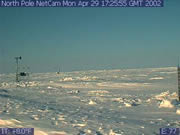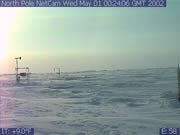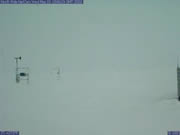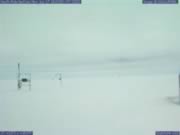About the North Pole Environment
From the NOAA/PMEL
Live North Pole Web Cam
April
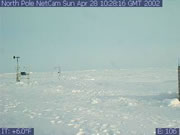 |
Sun is on the European side of the globe (shadows cast to the left) in this first image received from the North Pole web cam on 4/28/02 10:28 UTC. Snow conditions are typical for cold temperature of 6 F. In the foreground we see 40-50 cm of snow on top of the ice floe which is approximately 2.5 meters thick. From the anemometer, you can see the wind is blowing from Europe. |
May - June
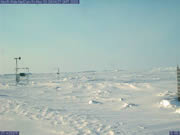 |
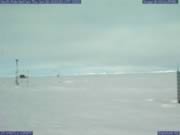 |
|
| 5/3/02, 20:34 UTC | 6/6/02, 16:01 UTC |
| Bright sunshine with warm temperatures of 15 F on 5/3/02 . Sun light from the Pacific Ocean side of the globe. The variations of snow depth can be seen in the image. Spring melting can be seen by comparing the snow in the right photograph from 6/6/02 with the left image from 5/03/02, just a month earlier. |
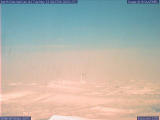 |
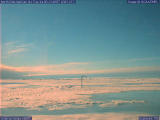 |
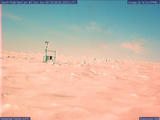 |
||
| Web Cam #1 5/13/03 06:26 UTC |
Web Cam #1 7/8/03 17:48 UTC |
Web Cam #2 6/8/03 5:37 UTC |
Similar rose colors were recorded in artwork from the 1890's by Arctic scientist and explorer, Fridtjof Nansen. Here are links to some of Nansen's artworks: Kara Sea, Sunset off the North coast of Asia, Off the Edge of the Ice-Gathering Storm, The Waning Polar Day, 22nd September 1893, Evening among the Drift-ice, 22ns September 1893, At Sunset, 22nd September1893. The Nansen pictures are "from the expedition with arctic ship toward the North Pole in the period June 24, 1893 to August 13, 1896, and are provided on the web by Nasjonalbiblioteket (The National Library of Norway).
July - August
 |
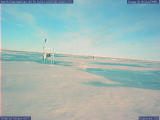 |
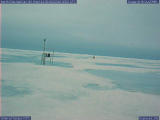 |
||
| Web Cam #1 7/8/03 17:48 UTC |
Web Cam #2 7/4/03 22:07 UTC |
Web Cam #2 7/9/03 06:22 UTC |
Why are there pools of water at the North Pole in summertime? The water is meltwater from the snow melting in Summer temperatures that are above freezing. The pools of water are called melt ponds, and are observed at both web cam locations. On the Web Cam 2 photographs, notice that the leg of the stand appears to have grown thicker between July 4 and July 9, 2003. The new "thickness" is the battery canister, which contains lithium batteries, which are light. The hole that was drilled for the canister is probably flooded by the meltwater, and the canister is floating up. This is good, since it means that the water won't get into the canister or the electrical connector on the lid. However, we hope that the canister won't float much higher and fall over.
Late
August - September
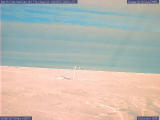 |
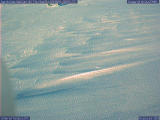 |
| Web Cam #1 9/4/03 13:03 UTC |
Web Cam #2 9/4/03 03:30 UTC |
| Autumn signals the approach of winter cold and darkness. In these pictures, the melt ponds have frozen, and a recent snow blizzard has covered them with wind-blown snow. |
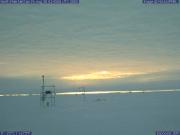 |
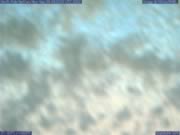 |
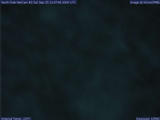 |
||
| 8/30/02 01:43 UTC | 9/9/02 09:32 UTC | 9/25/04 21:47 UTC |
The sun is low in the sky as Winter cold and darkness falls over the North Pole. Snow falls, and blowing snow or ice covers the camera lens. There may still be a bit of possible sunlight left in the season, and the melting from that sunlight, or sublimation by dry winds, may serve to remove the snow from the camera lens, but with the onset of winter, the camera will eventually remain snow covered. The North Pole is in winter darkness from October until March, and the North Pole web cam is re-deployed in April.
More about the North Pole Web Cams, images and environment
- What are you seeing in the images from the North Pole?
- What is Universal Time? GMT and UTC explained here
- Changing of the seasons at the North Pole from summer sun to winter darkness
- The puzzling summertime of 2003 by Dr. Norbert Untersteiner
- The short Arctic summer of 2004 by Dr. Norbert Untersteiner
| • Web cam Home and Acknowledgments | |
| • Daylight and Darkness at the North Pole | |



